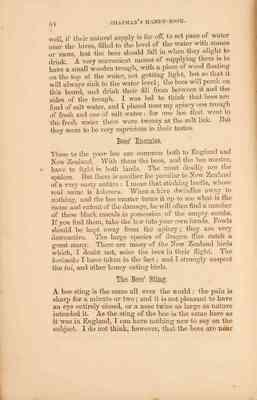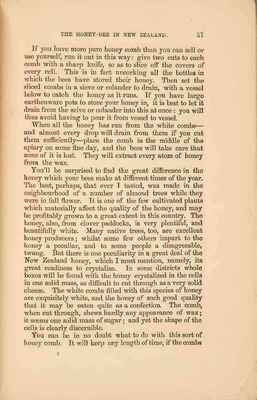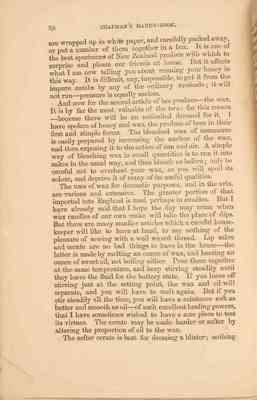Pages
54 CHAPMAN'S HANDY-BOOK.
well, if their natural supply is far off, to set pans of water near the hives, filled to the level of the water with stones or moss, lest the bees should fall in when they alight to drink. A very convenient means of supplying them is to have a small wooden trough, with a piece of wood floating on the top of the water, not getting light, but so that it will always sink to the water level; the bees will perch on this board, and drink their fill from between it and the sides of the trough. I was lead to think that bees are fond of salt water, and I placed near my apiary one trough of fresh and one of salt water: for one bee that went to the fresh water there were twenty at the salt lick. But they seem to be very capricious in their tastes.
Bees' Enemies.
These to the poor bee are common both to England and New Zealand. With them the bees, and the bee master, have to fight in both lands. The most deadly are the spiders. But there is another foe peculiar to New Zealand. of a very nasty nature: I mean that stinking beetle, whose real name is KEKERERU. When a hive dwindles away to nothing, and the bee master turns it up to see what is the cause and extent of the damage, he will often find a number of these black rascals in possession of the empty combs. If you find them, take the law into your own hands. Fowls should be kept away from the apiary; they are very destructive. The large species of dragon flies catch a great many. There are many of the New Zealand birds which, I doubt not, seize the bees in their flight. The KORIMOKO I have taken in the fact; and I strongly suspect the TUI, and other honey eating birds.
The Bees' Sting.
A bee sting is the same all over the world: the pain is sharp for a minute or two; and it is not pleasant to have an eye entirely closed, or a nose twice as large as nature intended it. As the sting of the bee is the same here as it was in England, I can have nothing new to say on the subject. I do not think, however, that the bees are near
THE HONEY-BEE IN NEW ZEALAND. 55
so irascible here as they are in England; and I account for it in this way: They have not so many enemies to contend with; the absence of wasps, in particular, enables them to preserve a more equal temper. I wish all Englishmen were as much improved in this respect as the bees are. Many remedies have been given for a sting; above all, pull the sting completely out, as it is barbed like a fish-hook, and will work into the flesh; then squeeze the poison outwith the pipe of a small key, as you would a thorn, and put a little honey on the place, just to keep the air away: if this is done at first, the swelling will generally be a mere nothing. The pain only lasts two minutes; at worst, it is only a swelled eye for a day or two. Another very common nostrum for rubbing on the place, after the poison is squeesed out of it with a key, is the washer-woman's blue-bag. Above all, never blow on your bees, they will try to sting directly, if you do. If they come all about you, making the noise which you will soon learn to know as a sign of anger, go quietly away, and put your head into a thick scrub, if any is near. This will brush them off. If you want to catch any of the bees, make a bold sweep at them with your hand, as though there was no such thing as a sting in the world; the bee will be so astonished that she will not sting at first. Then hold her in your closed hand, without pressing her, and she will not sting. I have so caught three or four at a time. If you want to do anything to a single bee, catch her, "as if you loved her," between your finger and thumb, where the tail joins on to the body: she thus cannot sting you.
Honey and Wax for Domestic Purposes.
Dr. Cumming says that:- It has been urged as a commercial question that honey is not now of the same importance as it was before the sugar-cane was discovered, and that gas has superseded wax candles. I am satisfied from many considerations, that if people would eat honey at breakfast instead of rancid London butter and nasty greasy bacon, not only would their health be
56 CHAPMAN'S HANDY-BOOK.
better, but their temper would be sweeter. I find invariably that people who like honey are persons of genial and affectionate temper. If Mr. Cobden and Mr. Roebuck had only taken honey at breakfast, or a very choice fragment of virgin honey at dessert, they would never have given utterance to those vinegar and aceticacid speeches which did them no credit. I wish somebody would send Mr. Spurgeon a super of good honey. Three months' diet on this celestial food would induce him to give up those shockingly bitter and unchristian tirades he has been lately making against the clergy of the Church of England. The producers of honey never draw their stings unless in defence of their homesteads, and the eaters and admirers of honey rarely indulge in acrimonious language. I believe a great deal of bad feeling is not moral or mental, but physical, in its origin. If you have in a congregation, or in a school, or in a convocation, some one who sets everybody by the ears, treat him to a little honey at breakfast for six months, and the "thorn will blossom as the rose." Therefore, as you take the honey combs out of the hive, separate those which are quite full from such as are only partly so; those which are pure white combs from such as are dark in colour, or have some of the cells filled with bee bread. This separation may easily be made by having several dishes or milk pans by you, in which to lay the different sorts of comb as they come to hand. By making this division at once, will save a good deal of honey; for if all the combs are heaped together in one vessel, the dark combs which are the hardest, will crush and otherwise injure the pure white combs; in them the wax is very thin and fragile, hardly able to bear the weight of the honey which they contain, and sinking immediately under any external pressure. Often you will find two sorts of honey comb, the pure and the impure, in the same cake. Separate them at once with a sharp knife. If you take a top box or a glass entirely full of pure honey, you need not be in a hurry to cut it out; it will keep better where it is, if only you place it in security, where no bee on a foraging excursion can possibly find it out.
THE HONEY-BEE IN NEW ZEALAND. 57
If you have more pure honey comb than you can sell or use yourself, run it out in this way: give two cuts to each comb with a sharp knife, so as to slice off the covers of every cell. This is in fact uncorking all the bottles in which the bees have stored their honey. Then set the sliced combs in a sieve or colander to drain, with a vessel below to catch the honey as it runs. If you have large earthenware pots to store your honey in, it is best to let it drain from the seive or colander into this at once: you will thus avoid having to pour it from vessel to vessel. When all the honey has run from the white combs - and almost every drop will drain from them if you cut them sufficiently - place the comb in the middle of the apiary on some fine day, and the bees will take care that none of it is lost. They will extract every atom of honey from the wax. You'll be surprised to find the great difference in the honey which your bees make at different times of the year. The best, perhaps, that ever I tasted, was made in the neighbourhood of a number of almond treees while they were in full flower. It is one of the few cultivated plants which materially affect the quality of the honey, and may be profitably grown to a great extent in this country. The honey, also, from clover paddocks, is very plentiful, and beautifully white. Many native trees, too, are excellent honey producers; whilst some few others impart to the honey a peculiar, and to some people a disagreeable, twang. But there is one peculiarity in a great deal of the New Zealand honey, which I must mention, namely, its great readiness to crystalize. In some districts whole boxes will be found with the honey crystalized in the cells in one solid mass, as difficult to cut through as a very solid cheese. The white combs filled with this species of honey are exquisitely white, and the honey of such good quality that it may be eaten quite as a confection. The comb, when cut through, shews hardly any appearance of wax; it seems one solid mass of sugar; and yet the shape of the cells is clearly discernible. You can be in no doubt what to do with this sort of honey comb. It will keep any length of time, if the combs
58 CHAPMAN'S HANDY-BOOK.
are wrapped up min white paper, and carefully packed away, or put a number of them together in a box. It is one of the best specimens of New Zealand produce with which to surprise and please our friends at home. But it affects what I am now telling you about running your honey in this way. It is difficult, nay, impossible, to get it from the impure combs by any of the ordinary methods ; it will not run -- pressure is equally useless.
And now for the second article of bee produce - the wax. It is by far the most valuable of the two ; for this reason --because there will be an unlimited demand for it. I have spoken of honey and wax, the produce of bees in their first and simple forms. The bleached wax of commerce is easily prepared by increasing the surface of the wax, and then exposing it to the action of sun and air. A simple way of bleaching wax in small quantities is to run it into cakes in the usual way, and then bleach as before; only be careful not to overheat your wax, or you will spoil its colour, and deprive it of many of its useful qualities.
The uses of wax for domestic purposes, and in the arts, are various and extensive. The greater portion of that imported into England is used perhaps in candles. But I haved already said that I hope the day may come when wax candles of our own make will take the place of dips. But there atr many smaller articles which a careful housekeeper will like to have at hand, to say nothing of the pleasure of sewing with a well waxed thread. Lip salve and cerate are no bad things to have in the house -- the latter is made by melting an ounce of wax and heating an ounce of sweet oil, not boiling either. Pour them together at the same temperature, and keep stirring steadily until they leave the fluid for the buttery state. If you leave off stirring just at the setting point, the wax and oil will separate, and you will have to melt again. But if you stir steadily all the time, you will have a substance soft as butter and smooth as oil - of such excellent healing powers, that I have sometimes wished to have a sore place to test its virtues. The cerate may be made harder or softer by altering the proportion of oil to the wax.
The softer cerate is best for dressing a blister ; nothing




